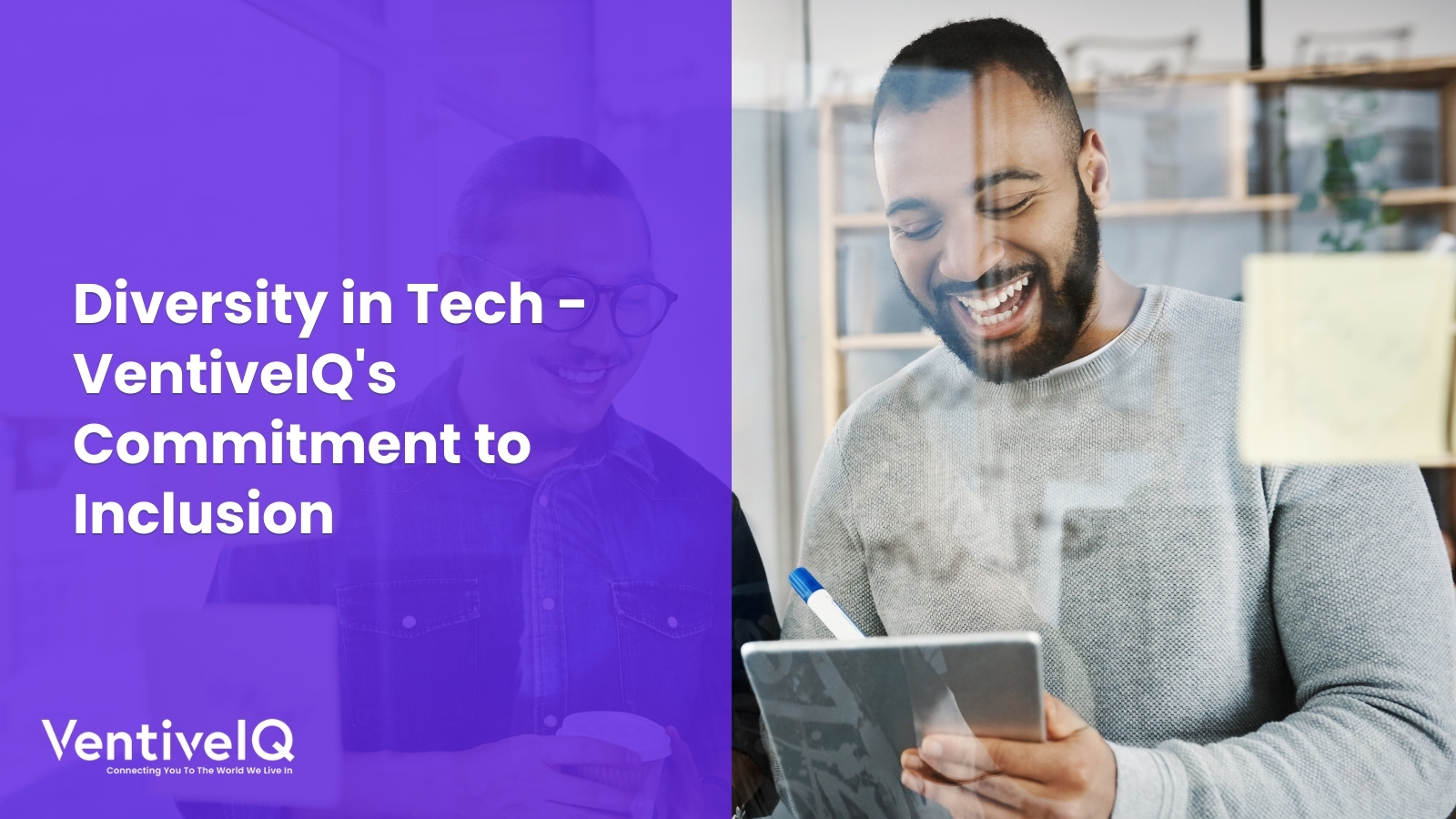Learn how VentiveIQ champions diversity in tech industry, fostering an inclusive culture for all. Explore the impact of workplace diversity & why it matters.
Introduction
The tech industry has long grappled with a lack of diversity, leading to homogenous perspectives and missed opportunities. However, a growing awareness of this issue is sparking a positive shift towards creating more inclusive culture workplaces that embrace a wider range of backgrounds, experiences, and ideas. At VentiveIQ, we understand the significance of diversity in tech and are committed to playing our part in driving this change.

This blog post delves into VentiveIQ’s journey towards building a diverse and inclusive culture tech workplace. We’ll explore the rationale behind our commitment, the concrete steps to achieve it, and the impact we hope to create within the industry and beyond. We’ll also discuss the challenges and trade-offs involved in this endeavor, offering a transparent and objective perspective that resonates with a general audience, particularly those interested in the USA tech landscape.
Why Diversity in Tech Industry Matters
Diversity in tech isn’t just a buzzword; it’s a necessity for driving innovation and ensuring that technology serves diverse communities effectively. The tech industry plays a pivotal role in shaping the future, from artificial intelligence to biotechnology. Without diverse perspectives at the table, innovations risk being myopic, catering to a limited demographic while overlooking the needs of others.
1. Fostering Innovation and Problem-Solving
Diverse teams bring together a tapestry of unique perspectives and experiences. This collective intelligence fuels creativity, leading to more innovative solutions and approaches to complex problems. By embracing diverse viewpoints, we tap into a wider range of possibilities, propelling the Diversity in tech industry forward.
2. Building Trust and Credibility
When tech products and services reflect the needs and realities of diverse communities, they gain greater trust and credibility. A lack of diversity can lead to products and solutions that miss the mark or even perpetuate harmful biases. By ensuring inclusivity, we build trust with a wider audience and contribute to a more equitable tech landscape.
3. Strengthening the Industry’s Talent Pool
The tech industry faces a growing talent shortage. Embracing diversity expands the pool of potential candidates, attracting individuals from various backgrounds who bring their unique skills and expertise to the table. This not only benefits individual companies but also strengthens the industry.
4. Ethical Imperative
Promoting diversity and inclusion is not just about business benefits; it’s also an ethical imperative. Everyone deserves the chance to contribute their talents and thrive in the Diversity in tech industry, regardless of their background. Building a more inclusive culture tech landscape creates a fairer and more just society for all.
The Challenge of Workplace Diversity in Tech
Despite its evident benefits, achieving workplace diversity remains a formidable challenge in the tech industry. Deep-rooted biases, systemic barriers, and unconscious prejudices often hinder progress toward building truly inclusive environments. From recruitment and hiring practices to company culture and leadership representation, every aspect of the tech ecosystem must be examined and revamped to embrace diversity fully.
At VentiveIQ, we recognize the urgency of this challenge and are committed to driving meaningful change. Our approach to fostering diversity and inclusion is multi-faceted, encompassing recruitment strategies, employee training programs, and company-wide initiatives to cultivate a culture of belonging.

VentiveIQ’s Commitment to Inclusion: From Words to Action
At VentiveIQ, we recognize the importance of diversity in tech and are actively working to cultivate an inclusive workplace culture. Here are some of the key steps we’re taking:
1. Building a Diverse Workforce
We are committed to diversifying our workforce at all levels, from entry-level positions to leadership roles. We actively recruit from diverse talent pools, partner with organizations focused on inclusion, and implement unconscious bias training for our hiring managers.
2. Fostering an Inclusive Culture
We strive to create a workplace where everyone feels valued, respected, and empowered to contribute their best work. We encourage open communication, celebrate diverse perspectives, and provide opportunities for professional development for all employees.
3. Implementing Inclusive Practices
We integrate inclusivity into our daily operations. This includes ensuring our products and services are accessible to a diverse range of users, implementing inclusive language guidelines, and offering flexible work arrangements to accommodate different needs.
4. Measuring and Tracking Progress
We are committed to measuring and tracking our progress towards diversity and inclusion goals. We regularly collect data on our workforce demographics, conduct employee surveys, and hold ourselves accountable for achieving our objectives.
Balancing Different Factors: Challenges and Trade-offs
Building a diverse and inclusive workplace is not without its challenges. Balancing different factors, such as individual merit, team dynamics, and affirmative action goals, requires careful consideration and ongoing dialogue.
Trade-off 1: Meritocracy vs. Affirmative Action
One challenge lies in balancing the principle of meritocracy, where individuals are selected based on their skills and qualifications, with affirmative action initiatives aimed at increasing representation from underrepresented groups. Finding the right balance can be complex, requiring open communication and a commitment to fairness and equity.
Trade-off 2: Individual Needs vs. Team Dynamics
Building diverse teams means accommodating a wider range of individual needs and perspectives. This can sometimes lead to challenges in team dynamics, requiring effective communication, conflict resolution skills, and a focus on building trust and understanding.
Trade-off 3: Short-Term Costs vs. Long-Term Benefits
Investing in diversity and inclusion initiatives can come with short-term costs, such as training expenses and recruitment efforts. However, the long-term benefits, such as increased innovation, employee satisfaction, and talent acquisition, significantly outweigh these costs. By focusing on the long-term impact, we can justify the necessary investments in building a truly inclusive workplace.
Exploring Different Approaches to Diversity and Inclusion
There are various approaches to achieving diversity and inclusion in the tech industry. Each comes with its advantages and disadvantages, and the optimal approach may vary depending on the specific context of each organization. Here are a few examples:
1. Top-Down vs. Bottom-Up
Top-down approaches involve leadership actively driving diversity and inclusion initiatives, whereas bottom-up approaches rely on employee-led efforts. A balanced approach combining both elements can be most effective, ensuring leadership commitment while leveraging the diverse perspectives and experiences of employees.
2. Data-Driven vs. Values-Driven
Data-driven approaches rely on data analysis to identify and address diversity gaps, while value-driven approaches focus on building a culture based on fundamental principles of inclusion and equity. Both approaches are essential; data offers valuable insights, while values provide the guiding principles for action.
3. Individual vs. Systemic Change
Focusing solely on individual behavior change, such as unconscious bias training, can be valuable but limited. For lasting change, systemic barriers to inclusion need to be addressed, such as discriminatory hiring practices and lack of accessible career development opportunities. A multi-pronged approach targeting both individual and systemic levels is most effective.

The Impact We Hope to Create: Beyond Our Walls
Our commitment to diversity and inclusion extends beyond our company walls. We actively collaborate with industry organizations, educational institutions, and community groups to advocate for systemic change and create a more inclusive tech landscape for everyone. We believe that sharing our experiences and learnings can inspire and empower others to join us in this essential journey.
Conclusion: A Journey in Progress
Building Diversity in tech industry is a continuous journey, not a destination. At VentiveIQ, we are committed to ongoing learning, adaptation, and improvement. We understand that challenges and trade-offs exist, but we are confident that by embracing diversity and fostering an inclusive culture, we can create a more innovative, successful, and equitable tech ecosystem for all. We invite you to join us on this journey and contribute your unique voice to create a brighter future for the tech industry.
